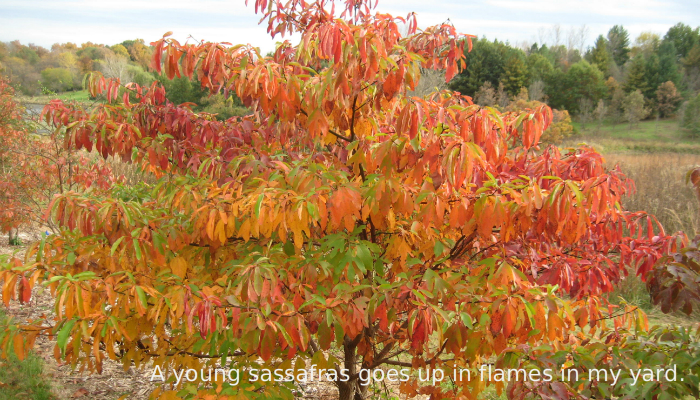The Strange Tale of Sassafras

By Lon Drake
In 1586 Sir Francis Drake returned to England from Roanoke Colony with a load of sassafras roots, plus some survivors who told wondrous stories about how this plant had rescued them from sickness and starvation in the wilderness. Its fame spread as a cure-all, and sassafras tea became a favorite drink in England.
By 1602 the price of the roots in London was an incredible 336 pounds sterling per ton. The following year, wealthy investors in Bristol funded a two-ship expedition aimed solely at bringing back as much sassafras as possible. They found the plant in quantity along the south coast of today’s Connecticut, and although altercations developed with the Indians, they succeeded. Others followed. By 1622, Jamestown Colony was required by the Crown to ship 30 tons of roots annually, as part of their charter.
Back then, disease was caused by evil, and sassafras became the anti-evil talisman, leading to the wood being used in bible boxes, spoons, cups, mattress stuffing, and other items that the owner would be reminded by the pleasant odor that the force was with him. But the reality was that it was not living up to the hype, and gradually people abandoned their faith in sassafras and imports dwindled to nothing. But the search for panaceas has continued uninterrupted to the present.
Britton and Brown, reporting on native vegetation existing more than a century ago, list sassafras’ range extending west to Iowa. Rydberg 1932 extends its range west into Nebraska. Peattie, writing much more than a half century ago, specifically says it’s here in southeast Iowa. Today, you would be hard pressed to find any in our landscape, which has been thoroughly overgrazed and/or plowed under, unless you come to my place, where we have been getting acquainted. Incidentally, most guidebooks mention that sassafras has three leaf shapes, often on the same tree. But I count four, because if you look closely there are both left- and right-handed mittens.
Sassafras has a close sister species, spicebush, and both are in the ancient laurel family, which developed in the company of the dinosaurs. Both have little yellow-gold flowers that unfurl early in the spring. Both produce bird berries; sassafras’ are little porcelain blue ovoids held up on bright red stalks, while spicebush‘s are little bright scarlet ovoids decorating the branches. The spicebush swallowtail butterfly caterpillar feeds on both of their leaves, and little else. Both also have separate male and female plants.
These sister species also have great autumn leaf color. The spicebush leaves all uniformly turn a brilliant clear golden yellow. But a patch of sassafras becomes a riot of orange, yellow, purple and red, every shrub doing its own thing, sometimes every leaf (see photo of a young one in my yard.) So I am finding it to be another interesting native to get involved with.
The uses for sassafras roots as flavoring mostly vanished about 30 years ago, when it was learned that in high dosages the oil caused liver tumors in lab rats. Today, the main culinary use seems to be the powdered leaves, which are an ingredient in filé, used to flavor southern gumbo.
Michael Dirr, the most qualified horticulturalist of our era, says, “On numerous back roads throughout the eastern United States there is no more inspiring sight than a sassafras thicket in full flaming fall color.” If you wish to try growing some here and invite the spicebush swallowtail, go for a mild winter microclimate with full sun and good to very good drainage – and enjoy your own riot of seasonal color.


